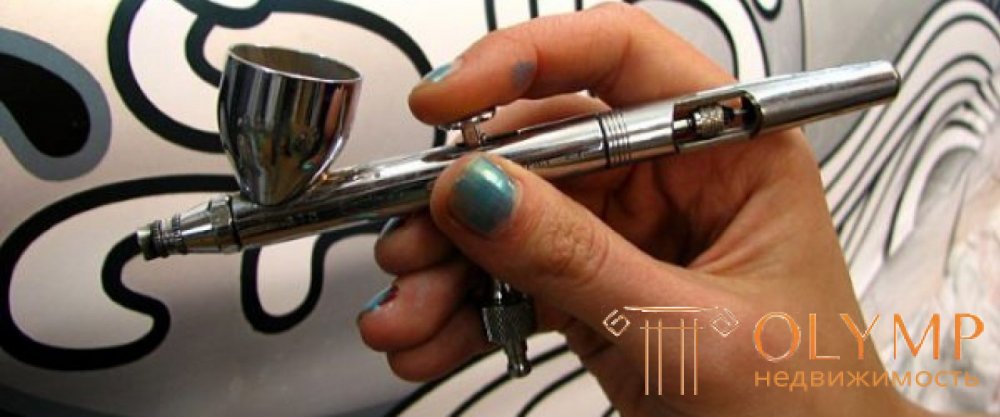
The technique of modeling the form using an airbrush is widely used in design and application graphics. The essence of this technique is that with the help of an airbrush (a device operating according to the principle of an ordinary spray gun) you can get a stream of sprayed paint solution. Depending on the need, a balloon attached to the bottom of the spraying device is filled with a solution of ink, watercolors, gouache or tempera paints, printing ink, etc. The density and intensity of the solution are consistent with the diameter of the outlet of the spraying device and the power of manual or mechanical compressor installation. If the solution is thick (saturated with large particles of coloring matter), then the sprayer may become clogged or give a stream with large drops. If the solution is liquid, then you will need to impose more layers of paint. Therefore, in the work with an airbrush, a solid practical experience in handling its mechanical parts and the skills of breeding different solutions and consistencies of coloring solutions are necessary. It should be remembered that immediately after working with solutions of chemical ink, gouache and other paints (especially tempera and printing), the spray device and airbrush balloon should be thoroughly rinsed.
When performing graphics using an airbrush, you should:
- work on paper stretched on a subframe or glued onto a tablet with a foundation made of thick cardboard or hardboard;
- cut masks from thick paper, cardboard or thick synthetic film with masks attached to the surface of the paper or to each other with adhesive tape or adhesive tape;
- before splashing the solution onto the image plane, make a test spray aside - on a clean sheet of drawing paper;
- before re-applying a layer of coloring solution should wait for the complete drying of the previous layer of spray;
- before spraying the surface of the paper should be primed with a liquid transparent layer of PVA glue or polyvinyl acetate whitener, apply the primer solution with a clean piece of foam rubber or with a soft pile brush;
- so that when applying the inner plane of the masks do not stick to the paper, their surface is sprinkled with talcum powder or tooth powder.
The technique of modeling the form using an airbrush is widely used in design and application graphics. The essence of this technique is that with the help of an airbrush (a device operating according to the principle of an ordinary spray gun) you can get a stream of sprayed paint solution. Depending on the need, a balloon attached to the bottom of the spraying device is filled with a solution of ink, watercolors, gouache or tempera paints, printing ink, etc. The density and intensity of the solution are consistent with the diameter of the outlet of the spraying device and the power of manual or mechanical compressor installation. If the solution is thick (saturated with large particles of coloring matter), then the sprayer may become clogged or give a stream with large drops. If the solution is liquid, then you will need to impose more layers of paint. Therefore, in the work with an airbrush, a solid practical experience in handling its mechanical parts and the skills of breeding different solutions and consistencies of coloring solutions are necessary. It should be remembered that immediately after working with solutions of chemical ink, gouache and other paints (especially tempera and printing), the spray device and airbrush balloon should be thoroughly rinsed.
When performing graphics using an airbrush, you should:
- work on paper stretched on a subframe or glued onto a tablet with a foundation made of thick cardboard or hardboard;
- cut masks from thick paper, cardboard or thick synthetic film with masks attached to the surface of the paper or to each other with adhesive tape or adhesive tape;
- before splashing the solution onto the image plane, make a test spray aside - on a clean sheet of drawing paper;
- before re-applying a layer of coloring solution should wait for the complete drying of the previous layer of spray;
- before spraying the surface of the paper should be primed with a liquid transparent layer of PVA glue or polyvinyl acetate whitener, apply the primer solution with a clean piece of foam rubber or with a soft pile brush;
- so that when applying the inner plane of the masks do not stick to the paper, their surface is sprinkled with talcum powder or tooth powder.
One of the most significant features of the airborne modeling technique is the ability to draw and cut masks. Masks are stencils made of paper, cardboard or synthetic films, which cover parts of the image that are not covered at the moment by dyeing solution. As the individual parts of the image are covered with layers of spray coloring, the masks of different shapes and sizes change. With the help of a jet of dye solution, one can “stretch” the tonal coverage of image planes, i.e., simulate transitions from light to dark, highlighting or darkening of certain parts of the paper surface.
Что бы оставить комментарий войдите
Комментарии (0)